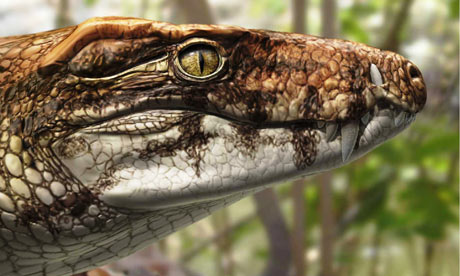 |
| The skull of Campinasuchus dinizi |
Earlier this year, a team of palaeontologists led by Ismar de Souza Carvalho from the Universidade Federal do Rio de Janeiro recovered the skull of a crocodile from late Cretaceous rocks within the basin. Named Campinasuchus dinizi, analysis showed that it was part of a group of reptiles known as the baurusuchids, a short lived but diverse family which inhabited the Mesozoic southern continent of Gondwana. What made it interesting was its snout.
Unlike other baurusuchids, its was shorter and tapered at the front which suggests that it was adapted to survive in an unstable, semi-arid environment where massive, catastrophic floods created temporary pools and lakes before drying up into a harsh desert. The team believes that it could have been such an environment which caused such a great diversity in the crocodile family. Fluctuating conditions would have created ecological niches ripe for exploitation.
 |
| A reconstruction of Campinasuchus dinizi, showing off the short, tapered snout |
The temporal range of the baurusuchids is just 25 million years from 90 to 65 million years ago. Such diversity could only appear if the group was successful, which stems from how well adapted the creatures involved are. The validity and true extent of the theory will become apparent when Campinasuchus is finally placed on the baurusuchid evolutionary tree (the researches have stated that its position is currently ambiguous).
Mesozoic South America was one of the most biologically diverse continents in the history of the Earth. It would suffer a terrible blow during the K-T extinction event due to its close proximity to the impact point of the asteroid. However, the millions of years of geographical isolation during the Cenozoic era would allow South America's fauna to reinvent itself as the next biological empire rose, bringing forth some of the largest and strangest mammals that the world would ever see.